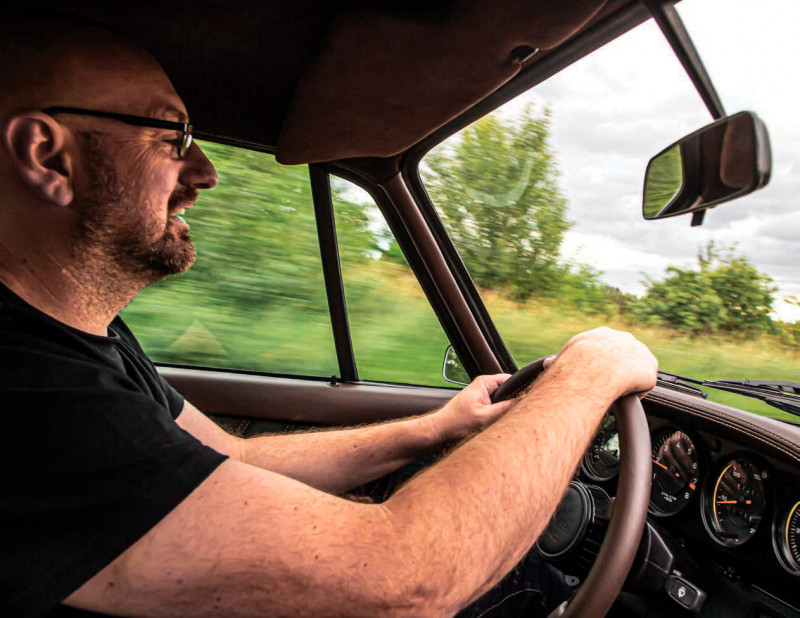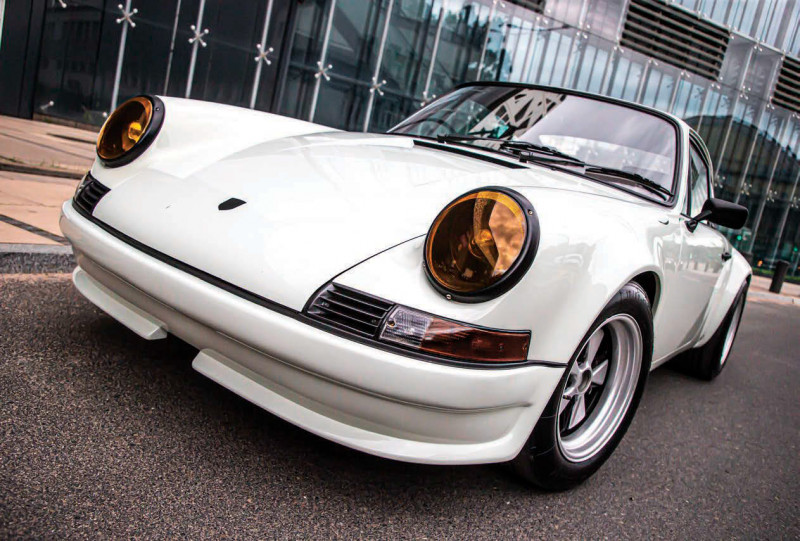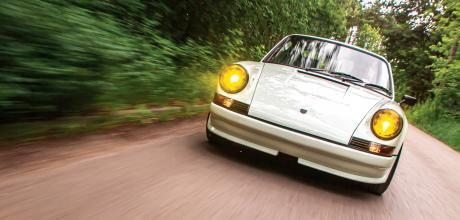250bhp 1970 Porsche 911 T project named Queen
CarBone is renowned for helping owners of air-cooled Porsches restore their rides. With its latest project, a 911 T named Queen, the company is now showing its capabilities as a restorer and modifier of complete cars...
Words and photography Robb Pritchard
EASTERN ROYALTY

THE CAR’S THREE-LITRE FLAT-SIX MAKES USE OF UPRATED CAMSHAFTS, PMO CARBS AND A MORE EFFICIENT CDI BOX
During the course of the past few years, Paweł Kalinowski has been on an epic personal Porsche journey, one most marque enthusiasts can only dream of. From humble beginnings creating his own classic Porsche engine bay stickers (“back then, you couldn’t get them from the manufacturer”), he has just finished a project which, until relatively recently, he and his friends would have considered utterly inconceivable. Through his company, CarBone, famous for being a supplier of high-quality accessories for classic Porsches, Paweł has overseen the ground-up restoration and personalisation of his very own air-cooled 911. She’s pretty special, which is why he named her Queen. Needless to say, we were excited to visit CarBone’s base in the eastern Polish town of Lodz to see this exciting new creation for ourselves.

ATTRACTING THE ATTENTION OF A KEEN CARBONE CUSTOMER, QUEEN WAS SOLD HALFWAY THROUGH HER THREE-YEAR BUILD
Going from making stickers at home to building a full historic Porsche is, of course, a massive step, and while there are plenty of 911 restomods and recreations out there, very few are done as a cost-effective, profitproducing commercial venture. Indeed, Paweł brought Queen to fruition via the same philosophy which saw CarBone grow from a single printer to a company with thirty-three employees.
All this in just eight years, following the train of thought ‘everything we do is for the Porsche enthusiast’. The dozens of small but always successful steps leading to Queen turning from dream to reality simply came from always saying yes to all client requests.
The simple remit for Queen was that it should be the lightest, best-handling and most well-appointed F-series 911 Paweł could develop. The donor car was a 1970 911 T with a history of major modifications. For example, at one point in the car’s fifty-two years, someone had seen fit to turn it into a bright yellow Flachbau with a 911 Turbo (930) whale tail. On the plus side, they also fitted a punchy three-litre flat-six. Mated to a 915 gearbox, the engine remains with the car and is now reconditioned.
Most of the build’s uncounted hours went into the shell, repairing half a century of rot, dodgy welding repairs and filler. “That’s an incredible number when you think about it,” Paweł says, estimating more than one and a half thousand hours went into the body alone. “Then again, there’s a huge sense of satisfaction gained from bringing back a 911 shell that was so far gone.” He estimates only fifty percent of the original metal remains, far beyond the point most people would have simply parted out what pieces they could sell as donor spares. “Queen is a prototype,” he continues, identifying the car’s role as something of a CarBone product test mule.
“Many hours were spent fitting bespoke parts, testing them and taking them off again for review and refinement. This means the next CarBone project car will take far less time to complete. This isn’t to say I’m about to launch a series of signature cars or some kind of production line, though. Each and every 911 to carry the CarBone name will be very different to what came before and therefore what will come thereafter.”
The gorgeous flares and ducktail hark back to the days of Porsche’s early RS and RSR-badged 911s and were made by none other than DP Motorsport, the company behind the monster Kremer K-Porsches, which came to dominate sports car racing in the 1970s. In co-operation with oil giant, Motul, DP Motorsport’s founder, Ekkehard Zimmermann, designed and built chassis for close to thirty Formula V and Super V race cars. With their special elegance, these race cars stood out on a crowded grid and encouraged Zimmerman to experiment with 911 spoiler modifications.
The results aroused the interest of Manfred and Erwin Kremer, who commissioned Zimmerman to produce a bespoke 911-based chassis for the racing arm of their Cologne-based Porsche specialist workshop. And, as we now know, these DP Motorsport 911 models played a massive role in winning several sports car and endurance racing championships, not least the 24 Hours of Le Mans. Needless to say, Paweł’s request for bespoke bodywork was in supremely safe hands.
STRONG WORK
As any tuner knows, the easiest way to make a car quicker is to make it lighter. To keep as many kilograms as possible off the bumpers, wings, rear arches, ducktail and hood, DP Motorsport manufactured them all from Kevlar. The roof is made from the same supremely strong composite material. Paweł tells us this was one of the trickiest things to get right. “The roof is glued to the shell,” he reveals. “There needed to be a step for it to be blended in. I absolutely refuse to use filler on any of our builds, which is why it took such a long time to get the right shape crafted into the metal. I guess you could refer to the CarBone team as Porsche ‘monks’ — we certainly took our time to get things right. Nothing was rushed. It really isn’t a problem if we have to approach a challenge a hundred times in order to get the perfect result.”
DP Motorsport made bodywork for race cars chucking out more than 800bhp. Queen is somewhat subdued by comparison. That said, the car’s three-litre flat-six makes use of uprated camshafts, PMO 46mm carburettors and a more efficient CDI box to bring the power up to a healthy — if rather conservative — 250bhp. A bit more current was needed to power some of the modern electrical equipment, including the Classic Retrofit airconditioning system, the wireless smartphone charger and the discreetly installed JL Audio sound system, which is why a larger alternator was fitted. The engine bay is a work of art in itself, but not only does it look gorgeous, the leatherette fire liner is a flame-retardant type normally used in the aviation industry. The suspension, meanwhile, benefits from Elephant Racing equipment supporting Bilstein B6 dampers and rear chassis bracing to make the car stiffer in corners. The wheels are fifteen-inch staggered Fuchs replicas measuring eight inches of width at the front and ten at the rear. They’re manufactured by Braid in the USA and Paweł has chosen to wrap them in Michelin TB15 rubber (225/50 front, 275/45 rear).
As we’ve highlighted in recent issues of Classic Porsche, CarBone has been producing bespoke 911 interiors to a high level of design and quality for several years. Even so, green automotive upholstery is a brave choice, bringing to mind poorly executed car cabins from decades past. Thankfully, the leather in Queen (“it’s olive, not green”) works well with the Chiffon White exterior paint. There’s a good amount of innovation in the cabin, not least the composite floor, which covers the sills and tunnel all the way to the back seats. CarBone leatheredged mats and footrests — the latter hiding the trick JL Audio equipment — perfectly complement the leather, as does the green (sorry, olive) painted houndstooth fabric covering the dash centre strips.
AROUND THE BENZ
The gauges are worth a mention, too. They’re fashioned in early Porsche style, but feature white digits and black bezels. The needles match what you’ll find in a modernclassic Mercedes — Paweł thinks they introduce a nice accent against the rest of the interior, which is dominated by BF Torino rally seats re-trimmed in-house at CarBone. He’s not wrong.
Even with this detail taken into account, none of what grabs your gaze indicates just how much attention to detail went into the paintwork, which took a staggering ten months to get right. “I would like CarBone 911s to be enjoyed for many years to come. With this in mind, Queen is built to last. To this end, the paint is a special mixture developed by my team and was applied in many layers, with much time for curing allowed between coats.” Details, such as the CarBone designed LED headlamps, the brass engine bay plaques (things have moved on significantly since the stickers which served as the catalyst for CarBone being established), the invisible sound system and Queen logo embossed into the steering wheel horn push serve to add further identity to this regal 911.
Most people who own a Porsche know looks and sound are secondary because such cars are really about the driving experience. The first thing to do after making myself comfortable in the gorgeously upholstered seats is to pull the knob with the icon of a tunnel entrance on it. It’s the loud button. Pulled, it releases a muffler bypass and makes the three-litre flat-six sing.
Through the CarBone GT3-style Sport exhaust system, benefiting from SSI heat exchangers, the big boxer makes a glorious bark. Pushed in, you can reduce the noise to a pleasant drone, ideal for motorway cruising, when you need to pass a race circuit’s decibel limit, or when trying not to wake the neighbours at the start of an early Sunday morning drive.
Paweł is right when he says the Elephant Racing suspension gives the car a hard, poised, but somewhat refined feel. The sticky Michelins deliver amazing grip. Pushing this Porsche around twisty back lanes on the outskirts of Lodz, it feels just as good as any racing 911 I’ve driven, from a 2.5-litre hill climb oriented 911 S to the Martini Racing Carrera RSR propelled to third place in the 1973 Targa Florio by Leo Kinnuen and Claude Haldi. Queen really is that good. Paweł is right to be pleased with my review. He’s created an absolute belter. Some of the roads around Lodz were in such bad condition, they turned into impromptu obstacle courses, forcing me to slalom around the many potholes. The suspension is far too hard to take any of these damaged strips of asphalt at speed, but with big holes in the road coming up unexpectedly, the brakes got a good test.
Queen stops very well, a consequence of the car’s hefty 996 calipers and discs, though there’s no servo. And it should be noted, standing at just 1,060kg with a half-tank of fuel is impressive considering the presence of airconditioning, audio equipment and the luxurious interior.
FLYING THE NEST
Talking of fuel, there’s a hundred-litre tank in the front. From empty to full, and when being pushed, the extra weight can cause noticeable differences in handling. To compensate for this, there is a handily placed break bias controller mounted on the transmission tunnel.
Attracting the attention of a keen CarBone customer, Queen was sold halfway through her three-year build. Paweł, after overseeing the tightening of every bolt and position of each spot weld, understandably views parting with the car as bittersweet. “Building a car like this from scratch is like having kids and then teaching them how the world works. We spend a lot of time together and we come to understand each other. We have bad days and better days. Then, before you know it, the child becomes grown-up and heads out into the world on their own. Porsche isn’t just a car brand, it’s the glue binding relationships between people who think about the manufacturer’s products in a similar way. I’m pleased to hand Queen to a CarBone customer I respect and trust. This is very important to my team — at CarBone, every single project is fuelled by emotion.”
He won’t be sad for too long — there are already other 911s being personalised in his workshop. We won’t have to wait three years before they appear in these pages, though. “What I’ve learned with Queen is that most people don’t want to wait a long time for a car to be built. We’ve now decided to prepare base cars up to a specific level, making them ready for CarBone clients to personalise with final details, like wheels and interior trim. These are easy for us to arrange, but enough for the customer to feel like they’re integral to the process of reassembly, allowing them to drive away in a 911 they feel completely invested in, emotionally, as well as financially.”
Like everything else Paweł has done with CarBone, this approach will undoubtedly be a success. Proving the point, the buzz surrounding Queen’s build has already generated to several more orders for bespoke 911s, a couple of which are already set to become magazine features. What this space!
Above The car is a rolling showcase of accessories offered through CarBone Below Paweł certainly had ‘one vision’ when creating the logo for this bespoke 911. Above Robb reckons Queen starts, stops and shifts just as well as any 911 he’s driven, including those configured for motorsport applications.
Above Interior is an unusual colour and one which might have looked terrible with the wrong accents, but Paweł has nailed the look Facing page The car as it was when it arrived in the CarBone workshop, plus the various stages of restoration, including application of panels made from Kevlar.
Above and below This transformed 1970 911 T is totally unrecognisable from the yellow flat-nose Paweł bought as the starting point for the project.
Below Three-litre flat-six has been tuned to a conservative 250bhp, though there’s more power to come from the unit.


